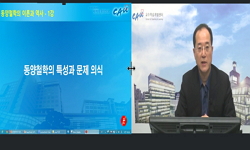A thorough understanding of the study of the Classics in the Chosŏn dynasty requires careful analysis of all of the classics. In this article, I will focus on one specific classical book, the Doctrine of the Mean. The interpretation of the Doctrine...
http://chineseinput.net/에서 pinyin(병음)방식으로 중국어를 변환할 수 있습니다.
변환된 중국어를 복사하여 사용하시면 됩니다.
- 中文 을 입력하시려면 zhongwen을 입력하시고 space를누르시면됩니다.
- 北京 을 입력하시려면 beijing을 입력하시고 space를 누르시면 됩니다.



INTERPRETATIONS OF THE DOCTRINE OF THE MEAN BY CHOSŎN CONFUCIAN SCHOLARS : TRADITIONAL/THEORETICAL AND REVISIONIST/PRACTICAL
한글로보기https://www.riss.kr/link?id=A100261906
- 저자
- 발행기관
- 학술지명
- 권호사항
-
발행연도
2014
-
작성언어
English
- 주제어
-
등재정보
AHCI,SCOPUS,KCI등재
-
자료형태
학술저널
-
수록면
673-693(21쪽)
- 제공처
- 소장기관
-
0
상세조회 -
0
다운로드
부가정보
다국어 초록 (Multilingual Abstract)
A thorough understanding of the study of the Classics in the Chosŏn dynasty requires careful analysis of all of the classics. In this article, I will focus on one specific classical book, the Doctrine of the Mean. The interpretation of the Doctrine of the Mean can be divided into two main academic scholarly groups: one group deepened and developed the Neo-Confucian system of thought inherited from Zhu Xi, while the other em-phasized the superior practical applications of the original Confucian philosophy and criticized the theory of Neo-Confucianism as too ideological without clear practical ap-plication. The former group emphasized two points. First, they expanded the theory of self-cultivation to include Neo-Confucianist theory concerning mind-nature. Second, pro-ponents of this group eventually developed the Neo- Confucianist theory of mind-nature as one of the core topics in the seventeenth-century Horak debate. The second group scholars rejected Zhu Xi’s authority with respect to the Doctrine of the Mean, including, for example, his thirty-three-chapter system of dividing the pre-viously undivided text of the book. Instead, this group criticized Zhu Xi’s addition of two chapters of his own to the Doctrine of the Mean, and used their own chapter system to divide the book, excluding Zhu Xi’s additions. They not only criticized Zhu Xi’s stance on metaphysical analysis, but also emphasized that the core of the Doctrine of the Mean should be to put the course of the Mean into practice in everyday life and human relations.
목차 (Table of Contents)
- ABSTRACT
- I. INTRODUCTION
- II. THE DEVELOPMENT OF NEO-CONFUCIANIM
- 1. The Development of Chosŏn Neo-Confucianism: The T’oegye School and Yulgok School
- 2. The Deepening of Chosŏn Neo-Confucianism: Han Wŏn-jin and Kim Wŏn-haeng
- ABSTRACT
- I. INTRODUCTION
- II. THE DEVELOPMENT OF NEO-CONFUCIANIM
- 1. The Development of Chosŏn Neo-Confucianism: The T’oegye School and Yulgok School
- 2. The Deepening of Chosŏn Neo-Confucianism: Han Wŏn-jin and Kim Wŏn-haeng
- III. CRITICAL INSIGHTS INTO NEO-CONFUCIANISM
- 1. Original Confucianism’s Emphasis on Practicality: Yun Hyu and Pak Se-dang
- 2. Encouraging the Possibility of Becoming True to the Way of the Human : Yi IK and Chong Yag-yong
- IV. CONCLUSION
- REFERENCES
동일학술지(권/호) 다른 논문
-
MAKING KOREAN MODERN MUSEUMS : JAPANESE COLONIAL BUILDINGS AS HERITAGE AND RESOURCE
- 계명대학교 한국학연구원
- KIM HYEON-JEONG
- 2014
- AHCI,SCOPUS,KCI등재
-
CREATING REGIMES OF VALUE THROUGH CURATION AT THE NATIONAL MUSEUM OF KOREA
- 계명대학교 한국학연구원
- CEDARBOUGH T. SAEJI
- 2014
- AHCI,SCOPUS,KCI등재
-
LIBERATED BY OPPRESSION : LITERARY REFLECTIONS OF COLONIAL KOREA BETWEEN THE UNITED STATES AND JAPAN
- 계명대학교 한국학연구원
- JOHN M. FRANKL
- 2014
- AHCI,SCOPUS,KCI등재
-
- 계명대학교 한국학연구원
- SOPHIE BOWMAN
- 2014
- AHCI,SCOPUS,KCI등재





 eArticle
eArticle







